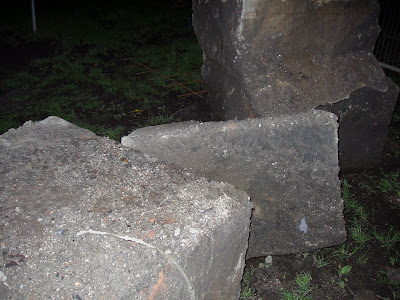
Well just when we thought summer was arriving, the typical new Mills weather returned with a vengeance, on Tuesday and overnight torrential rain raised the river level considerably which meant water coming into the excavation via the original exit tunnel and also a little through the coffer dam - Chris, Yvette and team soon had things back under control and what looked like an outdoor swimming pool at the start of the day soon resembled a site waiting for concrete to be poured by lunchtime which should start tomorrow (Thursday 1 May).
 The last of the overnight deluge being pumped away
The last of the overnight deluge being pumped away  Retaining wall is being reinforced - blocks for the area out of sight and original stone for the rest.
Retaining wall is being reinforced - blocks for the area out of sight and original stone for the rest.
Closer view of temporary United Utilities pipe

A JCB's eye view of the excavation.

This little contraption will help get the concrete in exactly the right place - this and a whole load of shovels and a lot of brute force.

































